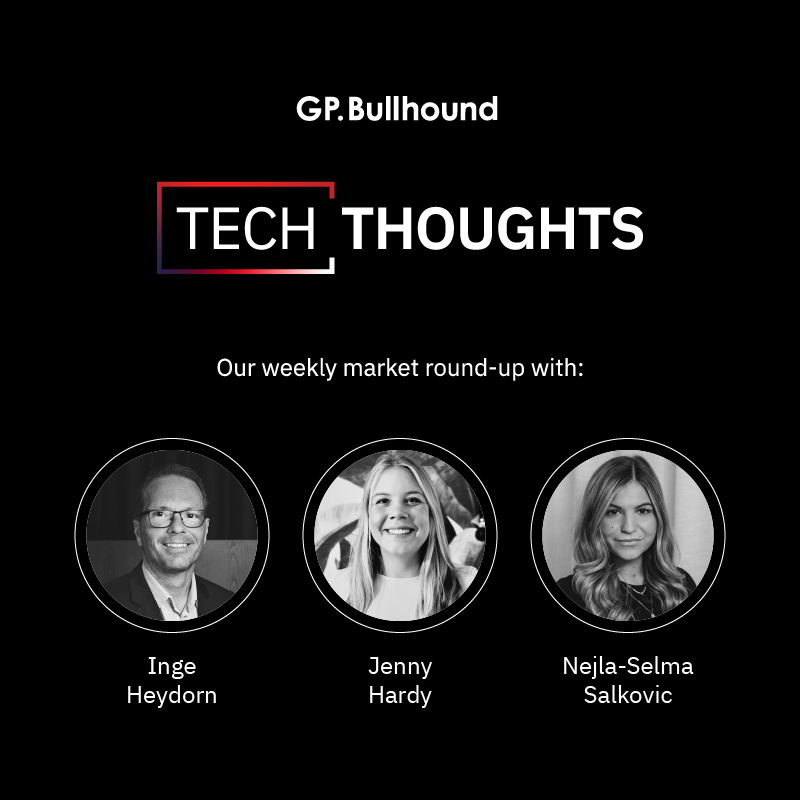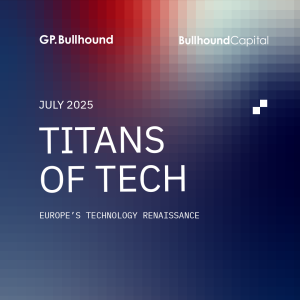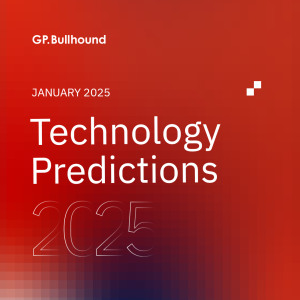Tech Thoughts Newsletter – 19 January 2024.

Market: A somewhat mixed week with China data spooking the market a little, but TSMC results help to drive a late rally in tech and semis. More on both below.
Portfolio: We made no major changes in the portfolio this week. Performance benefited from our holdings in TSMC and AMD.
The key event for us this week was TSMC results – the first in our portfolio to report. Results were good – we already had TSMC’s Q4 revenue from its monthly sales releases, coming in +13% qtr/qtr, at the higher end of the original guidance range. On top of that, gross margin and net income/EPS were better, but the most positive was its 2024 guidance and AI commentary – with the stock reacting positively (+6%) overnight in Taiwan.
Three key takes:
- 2024 semis recovery is on – AI as the key driver, TSMC as the key enabler
- TSMC revenue growth is forecast to be over 20% in 2024, having declined 9% in 2023.
- The market is now at the end of its inventory correction, which means reported growth can start to reflect more underlying demand, including AI as a significant driver.
- CEO comments: “2023 was a challenging year, but we also witnessed the emergence of AI with TSMC as a key enabler. In 2024, we forecast that the fabless semis inventory will have returned to normal inventory. However, macro weakness persists and geopolitical uncertainty is weighing on end market demand. 2024 will be a “healthy growth year” supported by 3nm, strong demand for 5nm and robust AI-related demand.”
- HPC (which includes AI – TSMC builds all of AMD and Nvidia’s chips) is forecast to be the highest growth of all segments this year – no surprise to us, and we believe it remains limited by supply – we think TSMC’s 5nm node revenue – which includes Nvidia’s H100 chips increased towards full capacity utilisation this quarter.
- There were also comments that TSMC will shift some of its 5nm capacity to 3nm, which might indicate that B100 – the next iteration of the H100 chips from Nvidia – will be built on 3nm.
2. No cut to capex expectations
- TSMC’s 2024 capex forecast was $28-32bn – flat on this year’s $30.4bn
- It’s important because TSMC makes up >30% of the wafer fab equipment market (we expect WFE to come in at ~$90bn from ~$85bn last year) which we’re exposed to in the portfolio
- The fact that TSMC (a big part of logic spend, alongside Intel) is broadly flat is helpful. 70-80% of that spend will be allocated for advanced processes (that’s good news for ASML – which we own). Its N3E node is built on ASML’s 3800 immersion tools (vs the prior 3600), which have a higher ASP (>€200m)
- The broader commentary was for capital intensity at TSMC to level off – it peaked at over 50% in 2021 and has fallen to mid-30 % in 2023 – it’s likely to remain at that level.
- It, of course, doesn’t mean that the absolute dollar number will be flat – it can grow with TSMC’s 15-20% long-term growth rate. Capex must stay high for N2, which should be in mass production in 2025. As we’ve noted before, N2 will use gate-all-around (GAA) technology.
- There continues to be a debate in the industry about when TSMC will move to GAA and 2nm, depending on Apple’s trajectory. But there is no doubt the industry will continue to push ahead into the leading edge nodes, which continues to be a significant structural driver of capex spend.
3. Tech leadership battle – insourcing/outsourcing with Intel
- Much of the call was around TSMC’s various N3 node iterations and the competition with Intel’s 18A node. Apple has been the first to use N3E with its M3 chips (it built its latest iPhone chips on the prior N3B node).
- TSMC has a great pipeline of further N3E customers – Qualcomm, Nvidia, AMD, Mediatek – and possibly the most significant – Intel.
- A large part of Intel’s latest processor (based on its Meteor Lake) is made at TSMC, and one of the key questions for the industry is whether Intel will stay or go back to internal sourcing. On the call, TSMC gave some clues that they expect Intel to continue to be a significant share of 3nm volume: “Let me repeat the last time I came in on their technology. The comment stays the same: the technology would be very similar or equivalent to TSMC’s N3P. We further check again with all the specs, transistor technology and everything. My comment stays the same, with a big advantage in the technology maturity. In 2025, they say that their newest technology will go into production. For TSMC, that will be the third year with a very high-volume production in the fabs. I don’t want to make too much of a comment on my customers’ claim, but let me assure you. We continue to have technology leadership and a broader base of customers. They are working with TSMC.”
- It’s important for the ongoing tightness of supply at TSMC’s leading-edge nodes; it’s important in clearly showcasing TSMC’s leadership (its biggest competitor has chosen to use their technology); and it’s important for Intel’s continued incentive to make its technology work – and to continue to spend large amounts of capex.
Portfolio view: We own TSMC, which continues to show tech leadership and high and improving returns on capital (thanks to its declining capital intensity). TSMC, Intel and Samsung make up ~80% of total wafer fab equipment spend, which is a market we’re exposed to via ASML, AMAT, LAM Research and KLA. Intel will likely give their capex guidance next week, while Samsung will probably not comment until later in the year. We continue to believe the tech leadership battle will drive high levels of spend – in particular, showing itself through ASML’s order book for its EUV/High NA tools. For Nvidia (owned), the fact that 5nm is running at close to full utilisation, and that comments indicate B100 will come at 3nm is positive – it likely means pricing can continue to increase.
China concerns – focus on market shares and pricing
- China retail data released this week showed slowing growth in December (+7.4% yr/yr from +10.1% in November). That caused some market volatility, with Tesla and Apple in particular in focus.
- For Apple (owned) and Tesla (not owned), we would argue it’s much more about the competitive environment that could hurt them rather than underlying market weakness – high-end smartphones and Electric Vehicles have been the bright spot in otherwise quite gloomy economic data in the country.
- As we commented in our letter last week, EV data in China for December continued to be strong, and smartphone sales in China – particularly high-end – remained strong until the year’s end.
- The issue for each of Tesla and Apple is much more about market shares – for Tesla – as well as BYD (which is now selling more battery-only vehicles than Tesla), there have been several new launches competing with Tesla at the higher end – Huawei’s luxury Aito M9 model was rumoured to have reached more than 20k weekly sales. At the very least, for Tesla, it means the aggressive price war it is facing in China continues.
- And for Apple, you have Huawei taking share (from a standing start with its Mate 60 Pro), with more models launching – its foldable phone is rumoured to have a 10m unit target this year. It’s worth remembering that Huawei used to have 16% smartphone market share in China, which declined to ~2% by 2022 (after the US blacklist). So Huawei indeed represents a credible threat to Apple volumes in China.
- Apple has begun discounting its iPhone 15 models in China this week. That rarely happens, so it’s not something to dismiss – and likely relates to the new competition they’re seeing in the market.
Portfolio view: We continue to be exposed to China EV through the semiconductor component companies that supply into the Chinese market (Infineon and NXP) – who are less vulnerable to pricing pressure than the OEMs. We remain cautious around broader consumer electronics exposure, where the recovery of Chinese demand remains uncertain.
AI news – OpenAI GPT store launches and Microsoft Copilot broadens launch
- In our 10th November 2023 letter, we wrote following OpenAI’s Dev Day, where CEO Sam Altman effectively described an App Store for Chatbots (or GPTs). A week later, Altman was fired, which apparently was one of the reasons for the delay in the rollout – it was finally released this week.
- Now, developers can add their custom versions of ChatGPT (OpenAI says there are already 3 million – remember from the OpenAI Dev Day that making a custom GPT is actually very easy – much more so than creating an App) to the GPT Store.
- There’s a significant chance that LLMs end up being totally commoditised. An LLM’s ultimate success is much more likely to come down to distribution and whether they are underlying source codes for other apps. As a result of that argument, we said that for OpenAI to be able to justify its $90bn valuation, it needed to be a consumer app and not just an LLM.
- OpenAI’s GPT store is one step closer to that. What’s still missing is controlling the end device – OpenAI will control the app store, but that app store will be on phones and PCs that it clearly doesn’t control.
- Staying on AI, this week Microsoft (owned) made its Office Copilot more widely available (to consumers too – at $20/month vs. the $30/month for commercial users).
- The commercial business is a much larger incremental revenue opportunity (400m commercial user base vs. ~80m consumers using Microsoft 365). Still, we’d put Microsoft high in the running (along with OpenAI) to capture the consumer AI opportunity.
- More broadly, it’s good news to the extent that Microsoft is happy enough with the Copilot experience to broaden it out into a consumer offering – one of the things we’re watching for most in 2024 is around the adoption and penetration of Copilot.
- Supermicro pre-released its numbers – a 30% sales beat vs expectations, driven by AI server demand – and we wonder if it benefitted from Chinese chip restrictions to get a better supply of Nvidia chips (as well as also possibly being an early recipient of supply of AMD’s MI300 chips)
- Samsung’s AI phone release was more about integrating Google’s Gemini into their phone than anything Samsung-specific (and therefore a disappointment from a Samsung perspective). It speaks to where the expertise lies in AI – and is a positive for Google to the extent that the Android ecosystem may be set to adopt Gemini.
- Finally, Mark Zuckerberg put out an Instagram reel detailing an installed compute capacity of 600,000 H100 GPUs. We’ve said before how incentivised all of big tech is to continue to invest in AI compute.
Portfolio view: Microsoft remains a top three position in the portfolio, and for us, the incremental revenue opportunity from Copilot remains among the most significant in the software space. To the extent that OpenAI’s GPT store opens up more innovation and more experimentation and ultimately means we’ll get to those new feasible revenue and business models, it’s good news for tech overall (and of course, for the underlying semis that are powering the compute).
Elsewhere in semicap – China trailing edge and localisation of semis continues
- At its results, TSMC spoke to its (subsidised) projects to build fabs in Japan, Arizona, and Germany: “In today’s fractured globalisation environment, our strategy is to expand our global manufacturing footprint to increase customer trust, expand our future growth potential, and reach more global talent. Our overseas decisions are based on our customers’ needs and a necessary level of government subsidy or support.“
- This week, we also had news that South Korea will invest KRW622trn ($473bn) to create 16 fabs by 2047. Samsung will contribute 500trn of that (in foundry and memory) and Hynix the rest (in memory).
- Elsewhere in semicap, Veeco (which makes thin film process equipment for semicap manufacturing) reported a December quarter beat, driven by China’s continued spending at the trailing edge nodes (>28nm). 2024 revenue guidance missed expectations – with the company baking in a drop in H2 China demand.
Portfolio view: Geopolitics and localisation of fabs continue to be an essential driver of semicap equipment, though we continue to keep in mind potential overcapacity concerns – as articulated by TSMC CEO C.C. Wei at this week’s earnings call too: “There might be too much of a capacity being built right now for mature nodes. So, the concern on overcapacity is valid.” It’s why we don’t own any of the trailing edge foundry services.
China tail risk/equity risk premium increasing
- China tech took a hit this week as a report was released linking Baidu’s chatbot, ERNIE, to Chinese military AI research. Baidu had a -10% reaction on the day.
- While Baidu denied any partnership, it’s not hard to imagine the military might have used its AI services.
- It means the risk of further sanctions remains heightened and we believe we’ll see more noise around China restrictions this year.
Portfolio view: We continue to hold no China tech. While they have strong returns on invested capital in many cases, the risk around government intervention and now sanctions is too high (and so the downside is almost impossible to frame).

For enquiries, please contact:
Inge Heydorn, Partner, at inge.heydorn@gpbullhound.com
Jenny Hardy, Portfolio Manager, at jenny.hardy@gpbullhound.com
Nejla-Selma Salkovic, Analyst, at nejla-selma.salkovic@gpbullhound.com
About GP Bullhound
GP Bullhound is a leading technology advisory and investment firm, providing transaction advice and capital to the world’s best entrepreneurs and founders. Founded in 1999 in London and Menlo Park, the firm today has 14 offices spanning Europe, the US and Asia.



